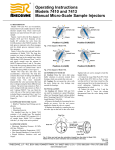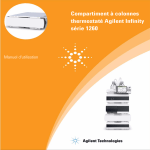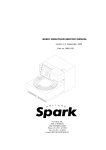Download Operating Instructions
Transcript
® Operating Instructions Type 90 and Type 3000 Switching Valves 1.0 DESCRIPTION Type 90 and Type 3000 valves are manual switching valves containing six or seven ports for a wide range of applications. Type 90 ports accept 1/16" fittings. Type 3000 ports accept 1/8" fittings and are for preparative scale applications. All Type 90 valves, Models 3000, and 3030 are PEEK versions, while Models 3000-038 and 3030038 are stainless steel versions. Model 9010 contains a position sensing switch. Model 9010 can be used as a manual sample injector with two-positions. A sample loop attached at Port 1 and Port 4 comes standard. When the sample loop is repositioned to Port 1 and Port 5, Model 9010 can be used in a 4-Way configuration. Removing the sample loop completely makes Model 9010 into a switching valve. Model 3000 or 3000-038 can also be used as a 4-Way valve (two-position) by connecting a loop to Port 1 and Port 5. Models 9030, 3030, and 3030-038 are Double 3-Way valves (two-position) and Model 9060 is a Six-Position valve. Figure 1 shows the flow diagrams of Type 90 and Type 3000 switching valves. The circles represent the ports in the valve stator. The dark grooves represent the connecting passages in the rotor seal. See Figure 3 for the flow diagram of Model 9010 as an injector. 2.0 SUPPLIED WITH THE VALVE Supplied in a separate bag are RheFlex® Fittings sets for all ports and the following items. Model 9010 also includes a 20 µL sample loop in a separate bag. • Hex Keys • Mounting Screws • Luer Tube (Model 9010 only) 3.0 SPECIFICATIONS • Maximum Operating Pressure: Models 3000 and 3030 - 28 MPa (276 bar, 4000 psi); All other models - 34 MPa (345 bar, 5000 psi) • Maximum Operating Temperature: 50°C • Flow Passage Diameters: Type 90 - 0.3 mm (0.013") and 0.5 mm (0.018"); Type 3000 1.0 mm (0.040") • Wetted Surfaces: Models 9010, 9030, 9060 - PEEK, ceramic, and an inert polymer; Models 3000-038, 3030-038 - stainless steel and PEEK; Models 3000, 3030 - PEEK 6 1 2 5 2 4 3 6 1 Position A 5 4 3 Position B Models 3000 and 9010 Switching Valve Two-Position, Six-Port 6 1 2 3 5 4 Position A 6 1 2 3 5 4 Position B Models 3000 and 9010 with Connecting Loop Four-Way Position A Position B Models 3030 and 9030 Double Three-Way 2 3 1 7 4 6 5 Model 9060 Six-Position, Seven-Port Fig. 1. Flow diagrams of Rheodyne switching valves. The stainless steel versions have the same flow diagrams. 4.0 IMPORTANT SAFETY NOTICES 4.1 Warning: (Using 9010 as an injector): When using sample loops larger than 100 µL, shield yourself from mobile phase coming out of the needle port when the valve is turned from INJECT to LOAD. Example: 1 mL loop ejects 20 µL upon decompression from 19 MPa (200 bar, 2898 psi). 4.2 Warning: Burst pressure of PEEK tubing depends on dimensions, solvents, temperature, and duration of exposure. A pinhole rupture in PEEK tubing can emit a high velocity jet of fluid that can penetrate skin and eye tissue. 4.3 Caution: Do not mount the valve with the ports facing up. Leakage due to a damaged rotor seal or loose fittings can cause the bearings to corrode. 4.4 Caution: Rinse the valve thoroughly after using buffer solutions to prevent salt crystals from forming, which can cause damage to the rotor seal and stator face assembly. 4.5 Caution: When using PEEK valves, use only RheFlex® PEEK fittings sets in the stator ports. Metal ferrules can cause irreparable damage to the PEEK stator. 5.0 INSTALLATION All switching valves can be panel mounted. Model 9010, as a sample injector, connects to different system components. See Caution 4.5. a) Connect the luer tube to Port 5 and the vent line to Port 6. Place the injection port at the same horizontal level as Vent Line 6 to avoid siphoning. b) Connect the pump to Port 2 and the column to Port 3. Leave the column disconnected from the valve during initial flushing. 6.0 OPERATION 6.1 INJECTIONS (MODEL 9010 ONLY) Before connecting the column to the injector, flush the injector with mobile phase in both the LOAD and INJECT positions. After flushing the injector, turn to LOAD, and connect the column. With the accessory injection port (P/N 9012 or 9013) or the luer tube supplied, you can load the injector by two methods: CompleteFilling and Suction Loading. Rheodyne LLC • A Unit of IDEX Corporation • 600 Park Court • Rohnert Park, CA 94928 • (707) 588-2000 • Fax (707) 588-2020 www.idex-hs.com Page 1 of 4 2320662B 10/08 6.1.1 COMPLETE LOOP FILLING In complete-filling, the volume of sample injected is set by the volume of the loop (this includes the valve passages). This method produces the highest precision. Overfill the loop with at least two to five loop volumes of sample. Six to ten loop volumes will provide even better precision. An excess of sample is needed because mobile phase near the wall of the loop is displaced slowly due to the laminar flow effect shown in Figure 2. To completely fill the loop (see Figure 3): a) See Warning 4.1 and turn to LOAD. b) Insert the syringe into the injection port. c) Load the sample. d) Leave the syringe in position and turn to INJECT. 6.1.2 SUCTION LOADING The preceding method exposes the sample to the metal needle of the loading syringe. Metal can be completely avoided by using a syringe to draw sample into the loop. The steps are as follows (see Figure 4): a) In LOAD, dip the tube attached to Port 6 into the sample. b) Insert an empty syringe into the injection port and draw sample into the loop. c) Leave the syringe in position and turn to INJECT. The metal needle of the syringe will contact the sample if an excess of sample is drawn into the syringe, but this excess sample is external to the sample loop and will not be injected. The syringe can be used many times before it needs to be emptied. To load the loop with all of the available sample, the loop should be at least four times the volume of sample loaded. The loop is first filled with mobile phase via the dip tube, then the whole sample is drawn into the dip tube and loop, followed by more mobile phase. The sample is now sandwiched between two zones of mobile phase in the loop. Sample Mobile Phase Tube Wall Fig. 2. Laminar flow effect. Flow 6.2 MODEL 9010 AS A 4-WAY Model 9010 can serve as a switching valve and a 4-Way valve by simply removing or changing the position of the external sample loop (see Figure 1). For 4-Way operation, reposition the 20 µL sample loop to Ports 1 and 5. Pressure Loading Pump 2 Column Waste 1 6 Loop Filler Port 5 4 3 Instrument Panel or Mounting Bracket Syringe Sample Loop Fig. 3. Using a luer tube to fill the loop by pressure loading. Suction Loading Pump 1 2 Column Dip Tube 6 4 3 Instrument Panel or Mounting Bracket Loop Filler Port Sample Vial 5 Syringe Sample Loop Fig. 4. Using a luer tube to fill the loop by suction loading. In suction loading sample is sucked from a vial into the loop using a dip tube. 6.3 SUGGESTED APPLICATIONS FOR SWITCHING VALVES Flush the valve with mobile phase before connecting the valve to system components. Suggested applications for switching valve applications are shown in Figures 5, 6, and 7. 7.0 ADJUSTING FOR LEAKAGE OR HIGHER PRESSURE OPERATION A single pressure adjusting nut at the handle end of the valve is used for pressure adjustment. If you need operation up to a higher pressure or if there is a leak between the stator and stator ring, remove the handle set screws. This gives access to the pressure adjusting nut. Using a wrench, tighten the adjusting nut about 1/20th turn. Use the red dot and punch mark as guides. Column A Sample Injector 2 1 6 3 4 Column B Position A 5 Detector If there is still leakage at this new setting, repeat the process. Finish by retightening the handle set screw into the hole on the shaft. Replace the rotor seal and stator face assembly if the leak continues. Note: When the valve is not panel mounted, the pressure adjusting nut can be hard to turn. In this case, loosen the three stator screws a 1/4 turn before adjusting the nut. Retighten the stator screws before testing for leaks. Note (Model 9010 Injector only): Vent Line 6 should be the same horizontal level as the luer tube to avoid siphoning. A siphoning leak will stop when the vent line and sample loop are empty. A leak due to a damaged rotor seal will continue. Column A Sample Injector 2 1 6 3 4 Column B 5 Detector Position B Fig. 5. Two column selection using Model 3000, 3000-038, or 9010 (without the loop). Rheodyne LLC • A Unit of IDEX Corporation • 600 Park Court • Rohnert Park, CA 94928 • (707) 588-2000 • Fax (707) 588-2020 www.idex-hs.com Page 2 of 4 2320662B 10/08 Pump A Pump A Sample Injector 1.00 Analytical Column 2 Detector 1.00 1 6 3 4 Position A 5 Pre-Column Waste Pump B Analytical Column Detector 1.00 Fig. 6. Stripping method of sample clean-up using Model 3000, 3000-038, or 9010 (without the loop). Pump 1.00 Sample Injector 2 3 1 2 5 4 4 5 3 1 4 6 3 4 5 Position B Pre-Column Waste Pump B 1.00 valves), stator, stator face assembly, and stator ring from the body. e) Pull the rotor seal off the pins. f) Leave the isolation seal and bearing ring in place. On Model 9010, remove the isolation seal. 6 7 2 1 Handle Assembly 3 2 Detector 1 Sample Injector 6 5 Fig. 7. Five column selection using two Model 9060 valves. The tube connecting Port 6 in the valves is used as a flush-out line. 8.0 MAINTENANCE The only parts that may need eventual replacement are the rotor seal and stator face assembly. Abrasive particles in the sample can damage the rotor seal and stator face assembly surfaces. Genuine Rheodyne® parts are easily replaced by the following instructions. 8.1 DISASSEMBLY To disassemble the valve, refer to Figure 8 and proceed as follows: a) Remove the handle assembly by loosening the handle set screw(s). b) Remove the valve if mounted on a panel. c) Remove the three stator screws. d) Remove the stator support ring (Type 90 Stator Screws (Type 3000 valves only) Pressure Adjusting Nut Body Thrust Bearing Spring Washers (4) 8.2 REASSEMBLY Shaft Assembly* Body Locating Pin To reassemble the valve, refer to Figures 8 and 9 and proceed as follows: Position Sensing Switch (Model 9010 only) a) On Model 9010, put the new isolation 60° Stop Ring seal on the shaft assembly with the open side Seal Pins (4) facing the handle. Bearing Ring b) Orient the new rotor seal as shown in Isolation Seal Figure 9. For six-position valves, orient the Rotor Seal rotor seal on the rotor relative to the arrow on the shaft. The rotor seal grooves face the Stator Ring stator. c) Replace the stator ring so that the pin in Stator Locating Pin the stop ring enters the mating hole in the Stator Face Assembly stator ring. For Type 90 valves, confirm that the position sensing switch falls into the mating hole in the stator ring. Stator d) On Type 90 valves, place the stator Stator Support Ring support ring onto the stator. Be sure the (Type 90 valves only) stator support ring's bumpy inner contour fits into the mating contour of the stator. Stator Screws e) Place the pins in the new stator face (Type 90 valves only) assembly into the mating holes in the stator. The three stator face assembly pins in the * Shaft assembly includes shaft, rotor, and pins. Type 3000 valves fit into the mating holes in Fig. 8. Exploded view of Rheodyne switching the stator only one way. valves. f) Replace the stator and stator face the two handle set screws into the hole on the assembly on the valve so that the pin in the shaft. stator ring enters the mating hole in the stator. g) Replace the three stator screws. Tighten each screw a 1/2 turn past fingertight. h) If panel mounted, remount the valve onto the panel. i) Replace the handle assembly and tighten Page 3 of 4 2320662B 10/08 Rheodyne LLC • A Unit of IDEX Corporation • 600 Park Court • Rohnert Park, CA 94928 • (707) 588-2000 • Fax (707) 588-2020 www.idex-hs.com Stop Ring Shaft End Rotor Pin Notch Models 3000(-038) and 9010 Models 3030(-038) and 9030 Model 9060 Fig. 9. Correct rotor seal orientation as viewed from the stator. 8.3 POSITION SENSING SWITCH IN MODEL 9010 The switch is a magnetic reed switch actuated by a magnet sealed inside the shaft. The switch is rated for 100 V at 200 mA. To replace or remove the switch: a) Remove the three stator screws. b) Remove the stator support ring, stator, stator ring, and stop ring. c) Pull the switch out of the stop ring. d) Replace with new switch, or leave the hole empty if the switch is not needed. e) Follow the steps in Section 8.2 to reassemble. 8.4 DETENT MECHANISM (SIXPOSITION VALVES ONLY) If mounting the six-position valve on an actuator, the detent mechanism must be disabled: a) Remove the stator screws, stator support ring, stator, stator ring, and stop ring. b) Loosen the handle set screw(s) on the knob and remove the handle assembly. c) Push the shaft through the body. d) Remove the two springs and two balls from the stop ring. e) Replace the shaft back into the body (shaft fits only one way). f) Follow the steps in Section 8.2 for reassembly. 9.0 OPERATING SUGGESTIONS AND TROUBLESHOOTING 9.1 LEAKAGE If you see liquid between the stator and stator ring, tighten the pressure adjusting nut as explained in Section 7.0. Replace the rotor seal and stator face assembly if the leak continues. 9.2 USE OF AQUEOUS BUFFERS OR SALT SOLUTIONS To prevent the formation of salt crystals in the valve, flush out the passages and vent line(s) with water after using salt solutions. 9.3 ACCURACY OF SAMPLE LOOPS Sample loop sizes are not actual values. The actual volume can differ by ± 10% for a 20 µL loop and ±5% for a 10 mL loop. There is a greater difference for smaller loops. 10.0 RECOMMENDED SPARE PARTS Rheodyne offers a RheBuild® Kit, including all the necessary parts, tools, and instructions for Model 9010, and offers genuine Rheodyne® replacement parts to maintain the quality performance of your valve. 11.0 WARRANTY All Rheodyne products are warranted against defects in materials and workmanship for a period of one year following the date of shipment by Rheodyne. Rheodyne will repair or replace any Rheodyne product that fails during the warranty period due to a defect in materials or workmanship at no charge to the customer. The product must be returned to Rheodyne’s factory in original packaging or equivalent, transportation prepaid. Damage occurring in transit is not covered by the warranty. This limited warranty is Rheodyne’s sole warranty of its products, and all other warranties of merchantability or fitness for any particular purpose are hereby disclaimed. Under no circumstances will Rheodyne be liable for any consequential or incidental damages attributable to a claimed failure of a Rheodyne product, even if Rheodyne has been placed on notice of possibility of such damages. 9010-999 RheBuild Kit for Model 9010 7030-015 Rotor Seal for Model 9030 7060-074 Rotor Seal for Model 9060 3710-008 Rotor Seal for Models 3000 and 3000-038 3030-005 Rotor Seal for Models 3030 and 3030-038 8125-094 Stator Face Assembly for Model 9030 9060-015 Stator Face Assembly for Model 9060 Rheodyne LLC • A Unit of IDEX Corporation • 600 Park Court • Rohnert Park, CA 94928 • (707) 588-2000 • Fax (707) 588-2020 www.idex-hs.com Page 4 of 4 2320662B 10/08













